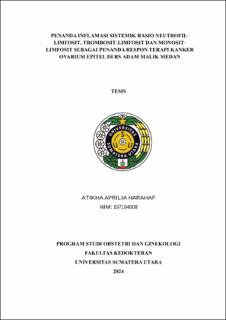| dc.description.abstract | Background: Ovarian cancer has a complex pathological type, high recurrence rate, poor therapy response and prognosis. In recent years, examination of inflammatory markers of ovarian cancer therapy response has been developed. Systemic inflammatory response is closely related to cancer initiation, development and metastasis so that it can be used as a therapy response of ovarian cancer. This study aims to determine the systemic inflammatory markers NLR, TLR and MLR as a therapy response of stage III epithelial ovarian cancer patients after optimal debulking and complete adjuvant chemotherapy.
Methods: This study is an observational analytical study with a diagnostic test design on systemic blood inflammatory markers NLR, TLR, and MLR as therapy response markers of epithelial ovarian cancer patients in Adam Malik Hospital Medan using retrospective data. This study involved 135 patients with stage III epithelial ovarian cancer who had undergone optimal debulking and complete adjuvant chemotherapy from January 1, 2018 to December 31, 2022 and complete follow up for 1 year.
Results: Based on the results of ROC curve analysis, the optimal cut off value for NLR was 2.4 (AUC: 73.2%, 95%CI: 64.1% 82.4%, p <0.001) with sensitivity of 69.9% and specificity of 66.67%. The optimal cut off value for TLR was 173 (AUC: 82%, 95%CI: 74.4% 89.5%, p <0.001) with sensitivity of 77.4% and specificity of 73.8%. The optimal cut off value for NLR was 0.5 (AUC: 66.2%, 95%CI: 54.9% 77.6%, p <0.001) with sensitivity of 71% and specificity of 69%. There was a significant correlation between NLR, TLR, and MLR values with therapy response of stage III epithelial ovarian cancer patients who had undergone debulking laparotomy and complete adjuvant chemotherapy (p <0.001). Based on multivariate analysis result showed that the most dominant variable in predicting therapy response of epithelial ovarian cancer patients was TLR with the largest OR value of 7.823 (95% CI 7.268 187.947).
Conclusion: The optimal cut off values of NLR, TLR, MLR statistically significant with therapy response of stage III epithelial ovarian cancer who had undergone optimal debulking and complete adjuvant chemotherapy. Increased levels of NLR, TLR and MLR most likely had non complete therapy response. | en_US |


